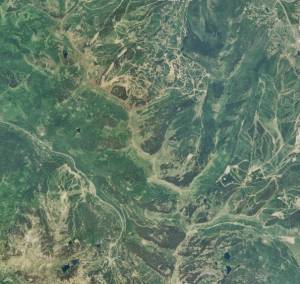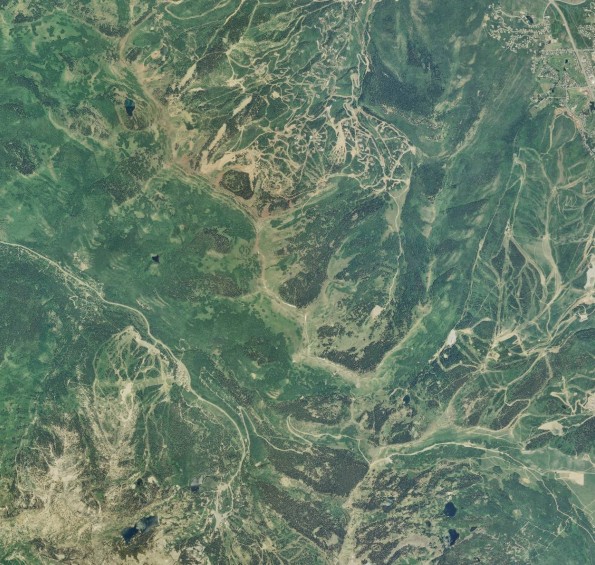Washington, DC – A number of interested parties testified before a House subcommittee last Friday, most of whom were opposed to the SkiLink gondola proposed to tie together Canyons Resort and Solitude Mountain Resort in Utah.
The two ski resorts, Canyons Resort in Park City in Summit County and Solitude in Big Cottonwood Canyon in Salt Lake County, are currently separated only by a ridge. Driving between the two resorts, however, takes 45 minutes to an hour, depending on traffic and weather conditions. Backers of SkiLink have proposed selling 30.3 acres of National Forest land to facilitate the two-mile, eight-passenger gondola lift’s construction, arguing that it will ease traffic in Big Cottonwood Canyon and contribute to job growth and the economy in Utah by linking the two resorts via an 11-minute lift ride.

Friday’s testimony was required as a first step to initiate the public and procedural processes of environmental, zoning and public comment for SkiLink. It will by necessity be followed by further procedures at the federal level before moving to the local level for public approvals and studies. SkiLink cannot be built without approvals and permits being issued by Salt Lake County and Summit County.
Salt Lake City Mayor Ralph Becker, Salt Lake County Mayor Peter Corroon, U.S. Forest Service acting deputy chief of staff Gregory Smith, and Jeff Niermeyer, public utilities director for Salt Lake City, all testified against the land sale on Friday in hearings before the House Natural Resources subcommittee on National Parks, Forests and Public Lands. Becker, Corroon and Niermeyer expressed opposition based upon impacts to both the environment and the Salt Lake City watershed, part of which is formed by Big Cottonwood Canyon.
The plan “violates our current policies, developed over decades of public processes, fails to acknowledge important resources and uses in the Wasatch Canyons, and would damage our prized environment and balance of public uses and users,” Becker and Corroon said in a joint statement.
Smith argued that splitting a roadless area in two runs counter to Forest Service efforts to unite land parcels within National Forest boundaries. Backers of the plan argue that the 30.3 acres of Forest Service land identified in the bill is sandwiched between several much larger private land parcels that are already owned by Canyons and Solitude. Environmental groups, including Save Our Canyons have also expressed opposition to the proposal. Niermeyer opposes any plan that unites seven Wasatch ski resorts — Alta, Snowbird, Brighton, Park City Mountain and Deer Valley, in addition to Canyons and Solitude — none of which are geographically situated more than a couple of miles from one another.
Proponents of H.R. 3452, also known as The Wasatch Range Recreation Access Enhancement Act which would authorize the land sale, include members of Utah’s Republican congressional delegation, including influential Senator Orrin Hatch, and Rep. Rob Bishop, chairman of the House Natural Resources subcommittee on National Parks, Forests and Public Lands. They argue that the bill “would infuse another $50 million a year into Utah’s economy and create 500 new jobs in the tourism and hospitality industries by creating the largest interconnected ski network in the United States and providing access to more than 6,000 acres of existing ski terrain.”
According to Wikstrom Economic & Planning Consultants, the ski and snowboard industry brought to Utah total spending of over $1.26 billion in the 2009-10 ski season and resulted in an additional $496 million in earnings and 20,000 jobs. Transportation development within and between Big and Little Cottonwood Canyons, however, remains a concern and is the subject of an ongoing Envision Utah Wasatch Canyons Tomorrow master planning process, as the Wasatch
Front population is expected to double in the next 30 years.
“I will always support measures that will give the state of Utah more control over Utah’s land,” said Mike Lee, a Republican U.S. Senator from Utah who also backs the SkiLink plan. “Tourism is an extremely important part of the state economy, and releasing this small section of land from federal control so that it may be sold and developed will improve Utah’s tourism appeal while increasing transportation efficiency and creating jobs.”
Parties testifying on Friday also included Canyons managing director Mike Goar, and Salt Lake County Councilman Michael H. Jensen, both of whom support the plan.
“We currently have no process to submit an application for SkiLink,” Goar confirmed. “By purchasing the land we will have a pathway to submit an application to the local governing agencies. H.R. 3452 requires the proposal meet all environmental requirements. If the land sale is approved we will then apply to Salt Lake and Summit counties for the development of SkiLink. This application will begin the process of environmental, zoning and other reviews as well as public comment.”
“According to the 2010 Utah Economic Report to the Governor, Utah’s skiing opportunities have attracted 4 million skier visits annually since 2005, despite the economic downturn,” added Jensen. “The Utah ski industry is an economic driver that has a positive ripple effect across multiple industries and regions in Utah. It is anticipated that the SkiLink project will build on that popularity and add dollars to the economy, create new jobs and increase tax revenue.
“According to a recent economic study, SkiLink will infuse $ 51 million into the Utah economy in its first year and provide $3,000,000 in increased tax revenue. When it opens, SkiLink is expected to attract 75,000 people. To date, out-of-state skiers add around $1.3 billion to the Utah economy supporting around 20,000 jobs. The addition of SkiLink will only enhance economic opportunities by adding 500 more jobs in Utah, something badly needed during recessionary times.
“There have already been multiple studies…over three decades,” Jensen concluded. “It’s time to do something.”
Late on Thursday, Canyons representatives released the complete environmental, economic and transportation studies that were conducted in 2010 to support the proposed ski lift that were conducted by InterPlan, RCLCO (Robert Charles Lesser & Co., LLC) and Cirrus Ecological Solutions, LC. While the Cirrus environmental study references a ski run, Canyons officials stressed that in early meetings held with interested parties, Canyons received feedback about a ski run contributing to watershed concerns. Based on this feedback the SkiLink route was revised and the ski run was eliminated. Additional studies will be required as this project goes forward.
The study conducted by InterPlan cites specific traffic reductions on SR-190 in Big Cottonwood Canyon and along I-80 through Parley’s Canyon and SR-224 in Summit County ranging from 464 to 1,259 vehicles daily. The preliminary environmental review conducted by Cirrus Ecological Solutions, LC found no “‘show stopper’ types of environmental issues in the areas of special status species, water quality and watershed resources, or visual resources. Based on the cited regulatory considerations, the resources present in the project area, and the nature of the proposal, it appears that any potential impacts would be minor and that most would be mitigable – nothing unusual for ski area infrastructure proposals that are routinely approved.”
Niermeyer, however, remains unconvinced, telling the Associated Press that the SkiLink proposal is “the camel’s nose under the tent” that could open the Wasatch Mountains to further ski area development.






“Backers of SkiLink have proposed selling 30.3 acres of National Forest land to facilitate the two-mile, eight-passenger gondola lift’s construction, arguing that it will ease traffic in Big Cottonwood Canyon and contribute to job growth and the economy in Utah by linking the two resorts via an 11-minute lift ride.”
11 minutes is impossible when it takes 4 minutes on the cabriolet, 10 on the “Orange Bubble”, 5 minutes to ski to Tomb Stone Lift, 8 minutes to ride that lift, another 8 minutes to Sun Peak Lift then 5 minutes to traverse to the SkiLink. Those times are rough assuming there is no control work causing a lift to be closed. Total time spent getting to Solitude via SkiLink: 51 minutes. I will take a 45 minute drive AND get first tracks thank you.
Interestingly enough, the inverse of what Talisker Corporation is claiming is true. Skiers from the south end of Salt Lake Valley will be more inclined to drive up Big Cottonwood, park in solitudes already too small lot, then take the 11 minute ride to the Canyons and get first tracks before anyone who parks at the Canyons is even to Red Pine Lodge. Hmmmmm.
That point is low on the issue totem pole. Hatch, Lee, Bishop and Chafettz all support a bill that is skirting public process by not allowing us sufficient time to object and doing it at a time when people will have the most difficulty organizing because of time constraints due to the holiday season.
This bill also undermining the years of work that Jeff Niermeyer and the Salt Lake County public has put into the Wasatch Canyons Tomorrow master plan. This survey reaffirmed what Salt Lake residence have been voting for again and again that we DO NOT WANT resort expansion. Case studies in the last 2 years: Altas proposed lift up Flagstaff Peak for “skier compacted avalanche control”. Snowbirds push for the mountain coaster up Superior. Yep that is a ski lift too.
If Talisker does buy this parcel of land in the next 10 years we will see a land grab by these resorts. Where will our water shed be then?
What seems to be missing in this discussion is the fact that the 30.3 acres in question was never for sale in the first place since it is Forest Service land that belongs to the public. Talisker and the Canyons knew that they would never get public backing to buy this land, so they hired a lobbyist, Ted Wilson, who then in turn made donations to the four extreme right-wing local politicians who are backing this bill. Two separate studies have shown that the people of the Wasatch Front (2 million strong) oppose ski resort expansion on to public lands and value open space and clean drinking water.
While this proposal might look good on paper, the reality is that the tram terminates in an ultra high-end, gated community and the ultimate purpose is to boost real estate sales. I have been skiing for 45 years, live five minutes away from this proposed tram and make a living in the ski industry, yet I would have no use for this tram and highly oppose it. It would be a tragic loss of public lands and set a horrible precedent for other ski resorts and developers to follow. A non skiing example of this would be if Donald Trump owned property on both sides of Central Park and coerced a bill through congress which allowed him to buy up a swath right through the center of the park to connect the two holdings. Not only that, but this tram is being pitched in terms of a transportation solution to a problem that doesn’t even exist, namely that hundreds of cars drive daily between the Canyons and Solitude.